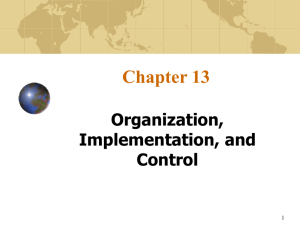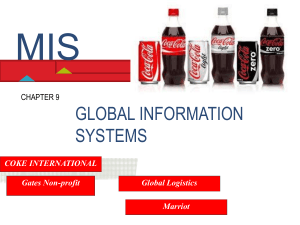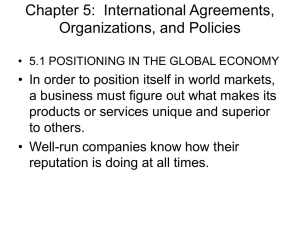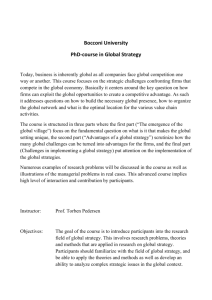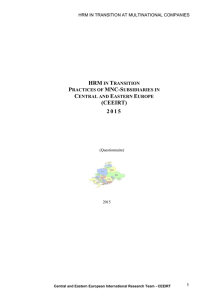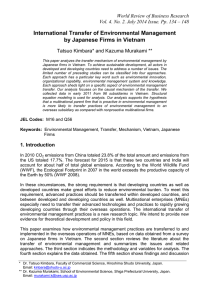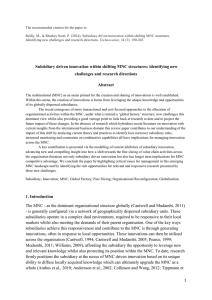MBA PROGRAMME 1999/2000 INTERNATIONAL BUSINESS
advertisement
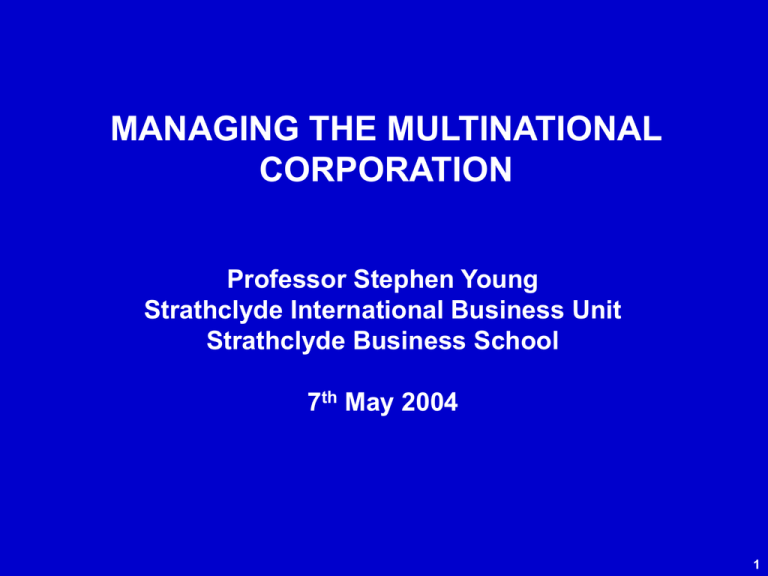
MANAGING THE MULTINATIONAL CORPORATION Professor Stephen Young Strathclyde International Business Unit Strathclyde Business School 7th May 2004 1 Foreign Direct Investment Worldwide, 2002 • • • • World FDI Stock: $ 7.1 trillion 10-fold increase since 1980 64,000 MNEs controlled 870,000 foreign affiliates Numbers employed by foreign affiliates – 53 million • Value added of foreign affiliates $ 3.4 trillion, about 10% of world GDP. • One third of world exports are intra-MNE. Source: UNCTAD (2003) 2 Definitions Multinational Enterprise • Owns (in whole or in part), controls and manages value-adding activities in more than one country. • An orchestrator of a set of geographically dispersed but interdependent assets. Micromultinational (mMNE) • SME that controls and manages value added activities through constellations and investment modes in more than one country. 3 What’s Different about Multinational Management? • Multiple operating environments – Diverse pattern of consumer preferences, channels, legal frameworks, etc. • Political demands and risks – Need to mesh corporate strategy with host country policies. 4 What’s Different (Continued)? • Global competitive game – Multiple markets, new strategic options • Currency fluctuation and exchange risk – Economic performance measured in multiple currencies • Organizational complexity and diversity – Need to manage complex demands across barriers of distance, time, language and culture. 5 Transition from International Multinational Global Transnational Can involve major shifts in: • Marketing, manufacturing, distribution, R&D –strategies and location • Financing • Human resource policies and practices • Management structures • Management information systems • Management compensation 6 Evolving Mentality: International to Transnational • International Perspective: Domestic company with foreign appendages; opportunistic FDI. • Multinational perspective: Overseas markets important; managed as a federation of quasiautonomous subsidiaries. • Global Perspective: World viewed as a single unit of analysis. • Transnational Perspective: Respond to global and host country pressures simultaneously. 7 International Corporate Strategy Model High Global Transnational International exporter Multidomestic Need for global integration Low High Low Need for localization 8 NEED FOR GLOBAL INTEGRATION Integration-Responsiveness Grid Telecommunications High Low Corrugated cardboard Low High NEED FOR NATIONAL RESPONSIVENESS 9 Wal-Mart: Key to Global Success Presentation by Vice-President, International Division, 16th February 2000 Benefits from globalization: • Global sourcing • Knowledge transfer e.g. glazed donuts • Global branding Strategy • Learn globally, act locally. 10 A Final Word: Risk of Globalization Glaucoma • Blindness to everything but global forces • Short-sightedness to localizing forces “As the 1990s were drawing to a close, the world had changed course, and Coca-Cola had not. We were operating as a big, slow, insulated, sometimes even insensitive “global” company; and we were doing it in an era when nimbleness, speed, transparency and local sensitivity had become absolutely essential.” Douglas Daft, CEO, Coca-Cola, March 2000 11 Evolution of Multinational Organization Structures • Hierarchical Structures – Export Department – International Division – Global structures (Product / Geography / Function / Customer) – Matrix structures • Heterarchical Structures 12 Multinational Matrix Structure Function cost centres Business Managers Business 1 Business 2 Business 3 Business 4 Business 5 Business 6 Business 7 Business 8 Asia Australia Inter America Europe United States Cost centres Business 9 Cost centres Mktg. Mfg. Res. IS&D Eval/ Cont. Functional professionalism Resource Managers 13 Multinational Hierarchy HQ S1 S2 S4 S3 Multinational Heterarchy H1 H2 H4 H3 H5 Hedlund; Bartlett & Ghoshal 14 Multinational Expansion Strategies (a) Host-market production (b) Product-specialisation for a global or regional market (c) Production / process-specialisation for a global or regional market 15 The Determinants of Subsidiary Roles and Mandates • What is a mandate? • Full-scope and limited scope mandates • Key success factors associated with attaining mandates – Existence of champions – Subsidiary competence – Stage in product life cycle, etc. • Are mandates allocated or earned? 16 Early Model of Subsidiary Roles / Mandates (White & Poynter, 1984) • Miniature Replica – Subsidiaries produce and market some of the parent product lines in the host country. • Rationalized Manufacturer – Subsidiaries produce component parts or products for regional or global markets (usually within the MNE). • Product Specialist – Subsidiary develops, produces and markets a limited product line for regional / global markets; World product Mandate. • Strategic Independent – Autonomous subsidiary. 17 Organizing Framework for Subsidiary Development Parent Company Devt Head Office Assignment Decision made by head office managers regarding the allocation of roles/activities to the subsidiary Internal Devt Subsidiary Choice Decisions by subsidiary managers regarding the roles/activities undertaken by the subsidiary Subsidiary’s Role Measured in terms of the specific business, or elements of the business, which the subsidiary undertakes and for which it has responsibility Host Country Devt Local Environment Determination Influence of environmental factors on decisions taken by head office and/or subsidiary managers regarding the roles/activities undertaken by subsidiary 18 Unleash Innovation in Foreign Subsidiaries Four possible approaches • Give seed money to subsidiaries • Use formal requests for proposals • Encourage subsidiaries to be incubators • Build international networks Source: Birkinshaw & Hood, Harvard Business Review, March 2001 19
